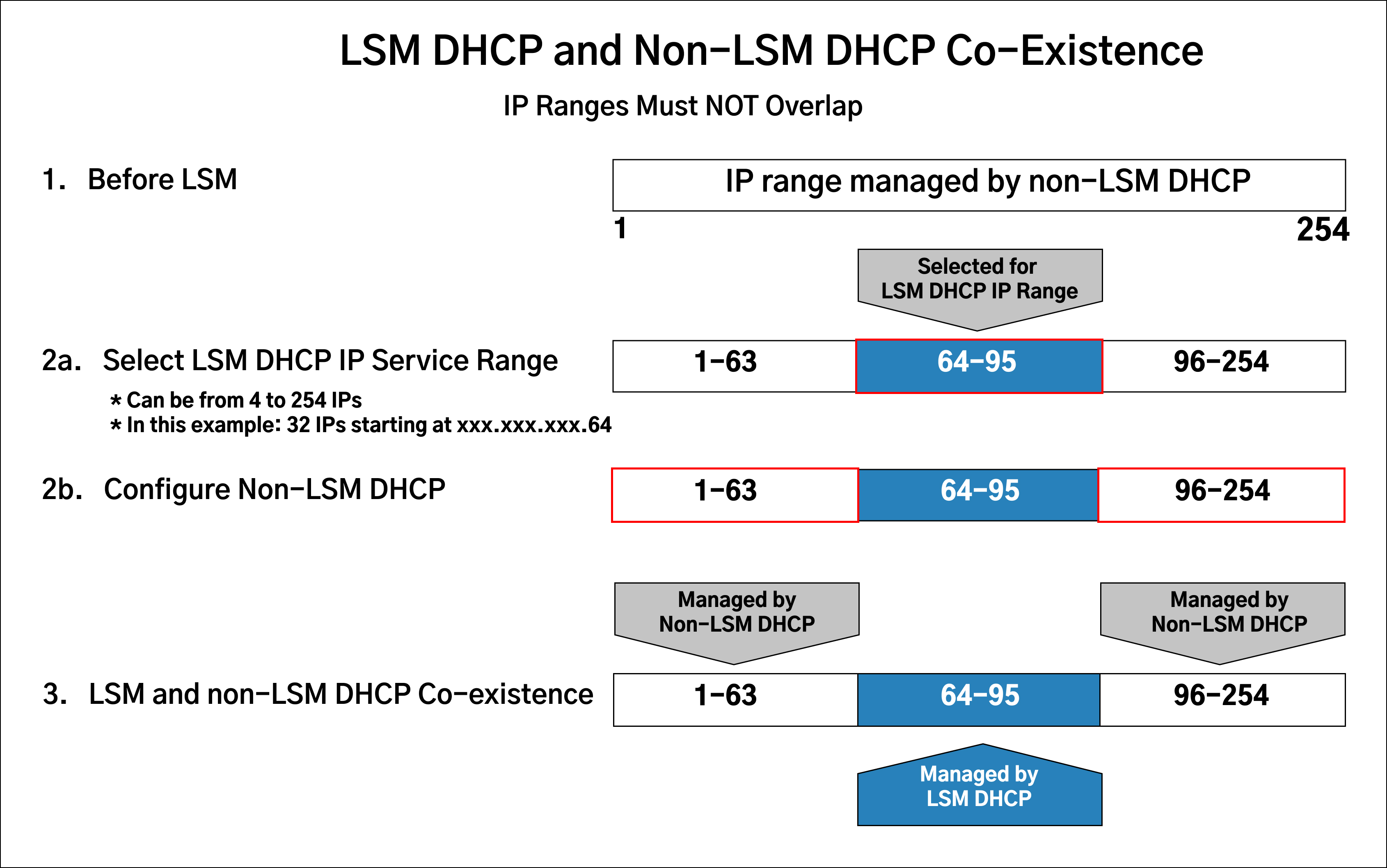LSM Installation Requirements at-a-glance:
1.Network selection (or design) and IP Address Space Planning
2.LSM Server Machine Selection
3.Installation Linux ISO Selection
Note: at this time, LSM supports only Machines with BIOS (not UEFI)
Network Selection and IP Address Space Planning
DHCP Overview:
•LSM does not require external DHCP service
•LSM provides its own DHCP service that:
oProvides a static IP service to Machines being serviced by LSM in the "LSM DHCP IP Service Range"
oIncludes a PXE listener on port 69
oDoes not use leases
oDoes not broadcast to other DHCP services
•If you have an existing DHCP service, it must be configured to exclude the IPs in your LSM DHCP IP Service Range
oRefer to non-LSM DHCP configuration
Network Selection and IP Space Planning
•Class C network with CIDR from /24 (254 usable IPs, subnet mask 255.255.255.0) down to /28 (14 usable IPs, subnet mask 255.255.255.240)
•Contiguous range of IP addresses, reserved for LSM (the "LSM DHCP IP Service Range")
o8 IPs minimum, 16 or 32 recommended (up to a maximum of 255 minus the last octet of your starting IP address)
oThese IP addresses are used by Machines:
▪During LSM service
▪Pending LSM service (set to "Netboot Ready")
▪Assigned by the User a "Reserved" (LSM DHCP static) IP address
▪Left powered on after LSM service if set to dynamic/dhcp addressing and if there is no non-LSM DHCP service
oIf you require a range of IPs less than 8 or greater than 254 IPs, contact Support
•Required during installation and upgrades (only): yum repository access (local or remote WAN internet mirror)
•Recommended during installation and upgrades (only): WAN (Internet) access to automatically download Clonezilla (otherwise download Clonezilla and copy to your system prior to LSM installation)
At OS installation time, you will be prompted for:
•LSM Server IP address : ___.___.___.___ (must be on the same subnet as the LSM DHCP IP Service Range)
At LSM Installation time, you will be prompted for:
•LSM DHCP IP Service Range starting IP address: ___.___.___.___.
•Number of contiguous IPs in your LSM DHCP IP Service Range: ___
Select a Machine for your LSM Server:
•Virtual (suggested because of the convenience of snapshots) or Physical x86-64/amd64 Machine, 4GB RAM or more, 2+ cores
•Firmware: Must use BIOS, not UEFI (UEFI will be supported soon)
•Disk: plan for enough disk space to accommodate the disk images you will be storing.
oA RHEL/CentOS system with LSM just installed (your "LSM Server") uses under 5 GB
oExpect an average 2.5 to 1 compression ratio for all major supported file system types. Examples:
Freshly installed OS |
Disk used on Machine |
Disk on LSM Server |
Compression |
|---|---|---|---|
Windows Server 2016 Standard |
13.8 GB |
6.6 GB |
2:1 |
CentOS 7.6 Minimal Install |
1.2 GB |
0.5 GB |
2.4:1 |
RHEL 7.6 Server with GUI |
3.8 GB |
1.4 GB |
2.7:1 |
RHEL 7.6 Server with GUI & extras |
5.1 GB |
1.9 GB |
2.7:1 |
Ubuntu 18.04 LTS |
4.5 GB |
0.9 GB |
5:1 |
oSuggested minimum size disk for trial purposes: 250GB (enough for a limited number of small Snapshots, knowing you can delete Snapshots if run low on space).
Detailed LSM Server Machine Requirements requirements
Installation Linux ISO Selection
Note: your ISO need not be the latest RHEL/CentOS 7.x since you will perform a yum update to bring the system current.
If you use Red Hat Enterprise Linux, obtain from your Red Hat Administrator or from Red Hat directly:
•Installation ISO, for example RHEL 7.6:
rhel-server-7.6-x86-64-dvd.iso
•Instructions and subscription credentials to register with Red Hat and enable correct yum repository access, as evidenced by successful execution of:
# yum -y update
If you use CentOS Linux, download an ISO from a public mirror such as https://mirrors.kernel.org
•Installation ISO, for example CentOS 7.6:
CentOS-7-x86-64-DVD-1810.iso
Note: CentOS yum repositories are accessible with simple Internet access and require no credentials
Proceed to Install Red Hat Enterprise Linux or CentOS Linux
Search keyword(s): network_access network_requirements lsm_server_requirements yum_access
